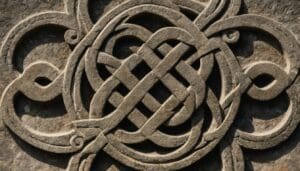St. Patrick’s Day: The Amazing Global Celebration Construed
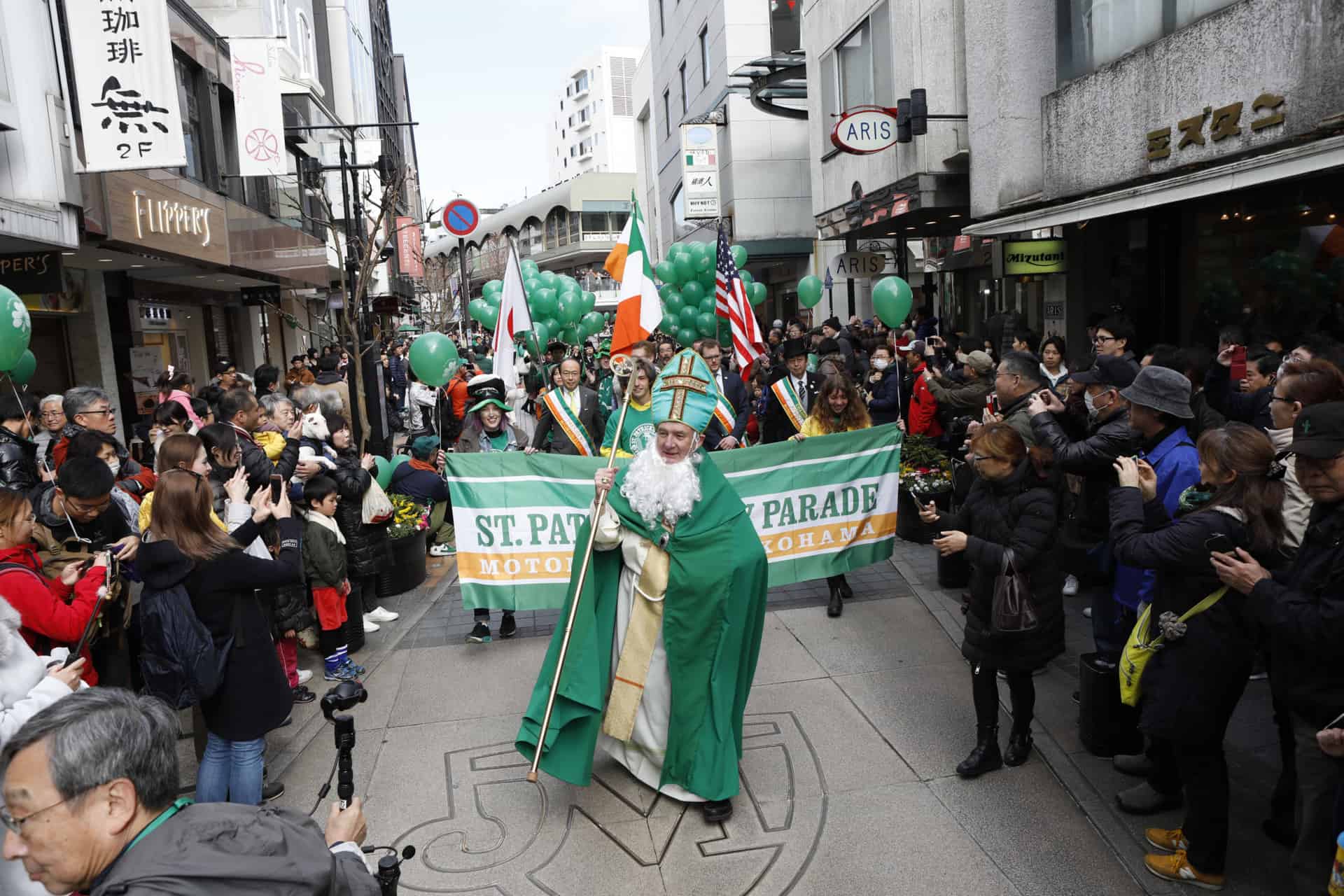
Updated On: March 27, 2024 by ConnollyCove
Bringing millions of people from different parts of the world together, St. Patrick’s Day is perhaps one of the most hotly-anticipated celebrations of the year. This religious and cultural event initially commemorates when St. Patrick, Ireland’s most recognised patron saint, died on 17 March. It has moved away from its origins throughout the festival’s more than 400 years and began receiving international recognition.
Contents
So Who’s St. Patrick?
Celebrations and Festivities
Parades
Food
Drinks
A Social Media Spotlight on St. Patrick’s Day
Side Dishes
St. Patrick’s Cathedral
St. Patrick’s Day in Numbers
Traditions, Myths, and Legends
An Extended Throwback of Ireland
But How and When Exactly Ireland came into Existence?
Heaped History
Landscape
The World Celebrates St. Patrick’s Day
A 1600-Year-Old Tale
So Who’s St. Patrick?
Even though St. Patrick is the patron saint of Ireland, he is not Irish. He was born in Britain near the end of the fourth century. He came from a very wealthy family of priests. His parents named him Pádraig.
As a teenager, St. Patrick was taken prisoner by Irish raiders and was brought to Ireland, where he spent six years in captivity, herding and tending to sheep. During his years in captivity, he was shocked at first when he knew that there was no religion in Ireland. So, St. Patrick turned to God for comfort and spent a lot of time praying.
In his autobiography, he confesses that he had a vision of God telling him to leave Ireland. After his escape, St. Patrick could return to Britain and was reunited with his family.
Becoming a Priest
In Britain, St. Patrick decided to become a priest like the other members of his family and began his religious training. After being ordained a bishop, St. Patrick returned to Ireland. He arrived there on 25 March 433 AD and began preaching the gospel throughout the land. With the help of his disciples, St. Patrick unburdened many people and started building churches all over the country.
St.Patrick’s Work in Ireland
In Ireland, St. Patrick shared Christianity with people. Because St. Patrick had lived in Ireland for so many years, he knew the language and the people. He combined old Irish customs and traditions with a new message about the Christian faith. He did this to help the native people keep their own culture. For example, St. Patrick invented traditions to honour the Easter holiday.
Easter, of course, is one of the most important Christian holidays. But the Irish didn’t celebrate Easter; they worshipped other gods, and they worshipped their gods with fire. St. Patrick used fire in his Easter celebrations. He used these ideas to explain this new religion. This also honoured the local culture.
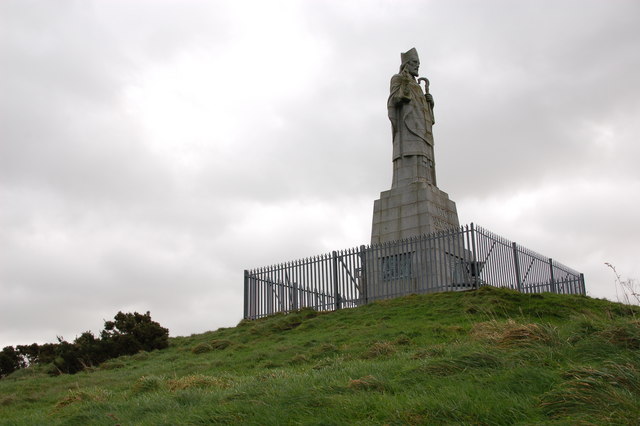
The Symbol of The Shamrock
For 40 years, St. Patrick converted and ministered to the people. He taught the many gospel principles, including the Holy Trinity. St. Patrick is also closely connected to the green shamrock plant. It has three leaves. Today, the Shamrock is the national flower of Ireland because St. Patrick used it to teach the people about the Holy Trinity.
St. Patrick died on 17 March 461 AD, in the south of Ireland,, where he built his first church. After his death, 17 March became St. Patrick’s Feast Day. Today, St. Patrick’s Day is celebrated all over the world. What began as a Roman Catholic holiday to honour and remember a beloved Saint is now an international celebration of Irish culture.
He also added a circle to the standard Christian cross. This became the Celtic Cross or the Cross of Ireland. The circle was the symbol of the sun. The sun was a powerful Irish symbol for many people. St. Patrick combined the circle and the cross. This showed that Jesus was like the sun.
Celebrations and Festivities
Every year, on 17 March, the city of Chicago in the United States does something unusual. They change the colour of the river that runs through the city. They use food colouring to turn the water green. Cool, right? They use about 18 kilograms of vegetable-based dye for the water to get this. They do all of this to celebrate St. Patrick’s Day.

Many St. Patrick’s Day celebrations involve a lot of food and drinks. Some of the food and beverages are green, too. Another tradition is to wear green. And if you do not, someone may just pinch you. They may pull a little bit of skin between two fingers. But Chicago is only one place that celebrates St. Patrick.
Globally Celebrated
People in cities and countries around the world celebrate him. People even celebrated this day on the International Space Station! Yes, in some cases, St. Patrick’s Day celebrations are out of this world. That was the case in 2013 when the holiday was celebrated there.
An astronaut named Catherine Coleman played an Irish flute and a tin whistle while floating weightless in orbit. And not to be outdone, Canadian astronaut Chris Hadfield also celebrated the day in 2013 by wearing green and taking photos of Ireland from space.
But the most significant celebrations today are in Ireland. It has been a public holiday there since 1903. Today, about one million people participate in the St. Patrick’s Festival in Dublin. This celebration is five days long. It includes parades, music, dancing, outdoor plays, fireworks, and more!
Parades
These celebrations evolved as the status of these groups within the mainstream culture improved. When large numbers of Irish people first immigrated to America in the mid-19th century, they were met with hostility and racism, spurring an era of nativism and anti-Catholic sentiment.
The first St. Patrick’s Day parade occurred nearly a century earlier. Still, it was not until this era that the celebration grew in size and scope and became a vehicle for moulding and celebrating Irish American identity.
However, as anti-Irish and anti-Catholic sentiments have diminished, the celebration has become more universal and less tied to Irish American identity, as common slogans like “Everyone’s Irish Today” seem to indicate.
As Irish people moved to other countries, the traditions went with them. The first St. Patrick’s Day parade was in New York City, in The United States, in 1762. Irish soldiers were serving in the English military there. They marched through the streets. This parade helped the soldiers feel a sense of their national culture. They celebrated the parade with Irish symbols, music, and food. One of the most popular instruments used in these parades was the bagpipes.

Different Parades Around The World
The Irish Foreign Ministry’s embassy network organizes over 350 events yearly to mark St. Patrick’s Day. The parade in Munich is the largest in mainland Europe, with 25,000 participants and spectators. The shortest St. Patrick’s Day parade in the world occurs in Hot Springs, Arkansas, on 98-foot-long Bridge Street.
San Antonio, Texas, is home to the world’s only St. Patrick’s Day River Parade. Tokyo has Asia’s most significant and oldest St. Patrick’s Day parade. There were 12 St. Patrick’s Day parades in Japan in 2016. The most southerly landmark to ever go green for St. Patrick’s Day is The Scott Base Sign in Antarctica. The Ice Concert Hall in Sweden’s Ice Music Festival is the northern greening event.
Food
St. Patrick’s Day can usually be a long day full of celebrations for any household member. So, starting the day with a good, hearty breakfast is a must. You will start the day with a Full Irish Breakfast if you want to follow tradition.
Full Irish Breakfast
To be a real Irish (breakfast), it must include bacon, sausages, eggs, Fadge, or the popular Boxty. Boxty is an awesome potato cake made with buttermilk (which the Irish use a lot), some potato, and some seasoning and they’re always fried. They’re perfect and popular. Adding a few slices of soda or wheat bread doesn’t hurt.
Wash all this down with lashings of tea, and you will be set up for the day ahead.
Main Dishes
St Patrick’s is the day for traditional Irish foods, such as hale and hearty fare, to fill stomachs and keep energy levels up. Without certain dishes leaving your stomach wanting more, no list of main course recipes would be complete. It’s true that in the US, it is traditional to eat corn beef and cabbage, but there are other superb Irish dishes from which to choose.
One of these main dishes is coddle. Coddle is a mixture of bacon, sausage, potatoes, onions, and possibly leftovers. There is no specific set of recipes because it mostly depends on cooking leftovers in a pot, half-boiled, half-steamed, and it’s called a coddle. Absolute comfort food.
Side Dishes
Of course, you can’t have the main courses without side dishes. Luckily, the Irish people present some fantastic ones, including colcannon and champ.
Take Colcannon for an example. It is a mashed potato dish (too many potatoes at this point, am I right?) with mixed kale or cabbage. So you cook it with either of those then add lots of butter, milk, salt, and pepper. It’s a succulent side dish, along with many other things.
Dessert
There is always room for something sweet on St Patrick’s Day. Barmbrack is one of Ireland’s most famous bakery products. It is a sweetened bread that has carrots and sweet fruit. It’s also super tasty. The name comes from “breach,” which means speckled, which refers to the fruit in the loaf. Guinness and Baileys Irish Cream also have a way of sneaking into Irish cakes and puddings.
Drinks
So, what do you think is the best about Dublin when it comes to eating and consuming whatever your belly desires? When in Dublin, you have got to check Ireland’s most famous export. I am not talking about Colin Farrell or the famous singer Bono; I’m talking about Guinness: Ireland’s most popular international drink.
There are many fine pints of Guinness in Dublin, but the source is at the Gravity Bar in The Guinness Storehouse. You can find one of the best, with amazing views of Dublin City. If you want to get under the surface and join some locals for a drink, head to L. Mulligan Grocer in Stoneybatter.
L. Mulligan Grocer has one of Dublin’s best craft beer and whiskey selections. It also has a handsome selection of stouts, pale ales, wheat beers, dark lagers, fruit and spiced beer, amber red and brown ales, gluten-free beers, and ciders. Ensure you’re thirsty and in the mood to indulge on St. Patrick’s Day.
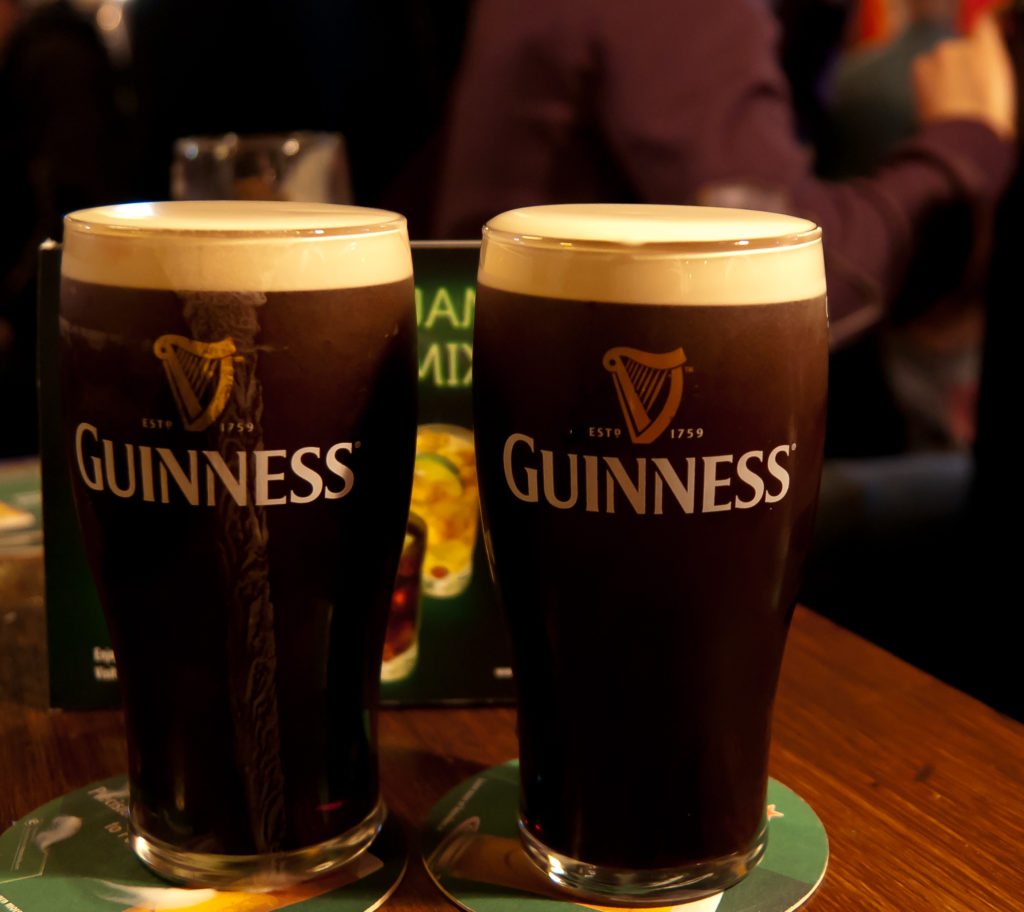
What about whiskey, or “uisce beatha” as it is known in the Irish language? The Irish have been said to have learned how to make it while on the Crusades, and they taught the Scots.
Ireland is essentially an Island of framers with terrific meat and dairy products. There, everything is sourced locally. People should try the Irish black pudding. The scotch eggs are great, too! It is truly an authentic destination for St. Patrick’s Day.
A Social Media Spotlight on St. Patrick’s Day
Holidays are an incredibly engaging time for brands on social media. 59% of marketers have claimed to use social media for more than 6 hours each week. Sure, most of the attention and money went towards Black Friday, Cyber Monday, and Christmas sales, but who said that the more minor holidays like St. Patrick’s Day couldn’t be engaging?
While most brands remain neutral, many big brands would somewhat not get pinched on the minor St. Patrick’s Day holiday and have branded their social media pages to celebrate it. Some famous marketing campaigns were established to promote the companies’ brands using St. Patrick’s Day branding.
McDonald’s
I don’t know about you, but when I think about St. Patrick’s Day marketing campaigns, I immediately think of McDonald’s limited edition Shamrock Shake.
For those of you who don’t know, every year, McDonald’s releases a green, mint-flavoured milkshake known as the Shamrock Shake for one month leading up to the festive day. This is a long-running campaign, and it gets a ton of hype every year from its customers awaiting its release.
In my opinion, the Shamrock Shake is a prime example of a great marketing campaign. It creates a sense of urgency and excitement in their customers for a seemingly average product, which would exist if they simply added a mint chocolate chip milkshake to their permanent menu.
Bord Bia
Bord Bia, the Irish Food Board, launched a St. Patrick’s Day competition in 2013 to promote the positive attributes of Irish Beef!
The campaign, created by Spinnaker, ran for six weeks and was titled ‘The Biggest St Patrick’s Day Feast ever.’ They asked fans via a Facebook app to choose their favourite menu they would like at their ‘virtual feast’. All participants were entered into a free prize draw to win a trip to Ireland for six people, and daily prizes were offered!
Discover Ireland
Just missing out on the top spot is tourism board Discover Ireland. They ran a photo and video competition encouraging fans to “Go Green” for St. Patrick’s Day. Participation gave entrants a chance to win a prize. This prize was for six people to go to Ireland for the homecoming event, The Gathering.
Although this campaign seems unremarkable in originality at first glance, it was ideal from a strategic standpoint, The concept and task were deliberately simple to stimulate participation across all demographics.
Users simply had to capture their best “green” photo or video to represent St. Patrick’s Day and the Irish. Would-be photographers were given carte blanche to include everything from fancy dress to Dublin’s most iconic buildings turned green using Photoshop. This creative license served to emphasise the inclusive nature of the competition further.
Guinness
Another famous Irish brand, Guinness, regularly has St. Patrick’s Day-themed campaigns on social media. This year, they used their platform to help give back to the community with their #StacheForCharity campaign.
Explaining the details on the brand’s Facebook Page, this campaign asks customers to share their experiences with Guinness, saying, “Adult beer lovers can sip their pint slowly and share photos of their stache”. Whether self-grown and groomed, drawn-on, or Guinness-enhanced – with @GuinnessUS using #StacheForCharity.
They donated £1 to the Guinness Gives Back Fund for every picture they received. A non-profit organization that helps provide communities with the support they need.
With creativity and planning, you can tap into the heightened traffic and buzz around holidays with social content that speaks to consumers and still conveys your brand message.
It is worth mentioning that public figures and celebrities on TV tend to wear green on St. Patrick’s Day. Some might even conduct hilarious segments to make fun of what happens on the occasion.
St. Patrick’s Cathedral
New York City is bursting with inspirational architecture and no surprise, the houses of worship do it best. St. Patrick’s Cathedral is one of its oldest and most iconic: A true New York landmark.
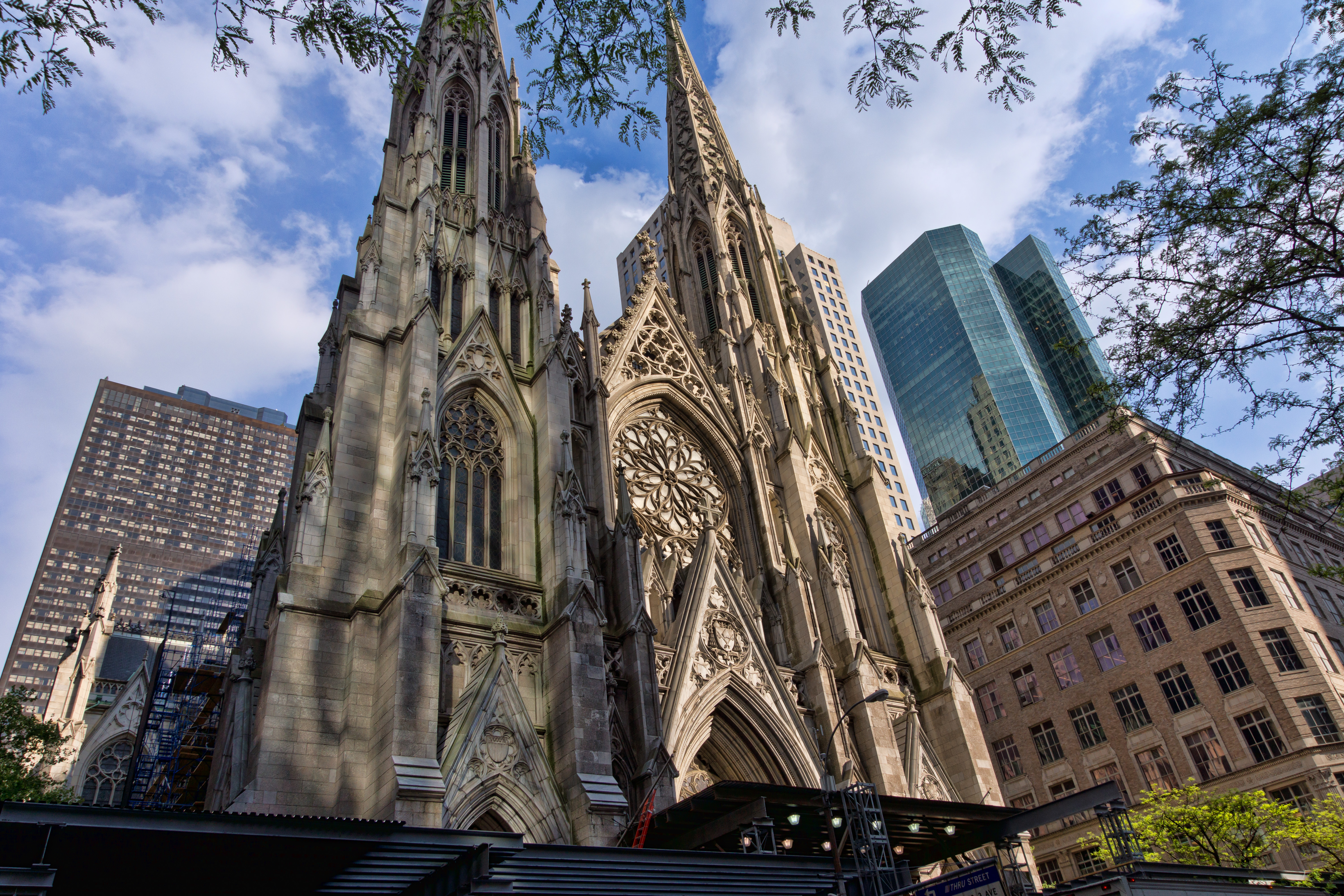
With more than 5 million visitors annually, everyone is welcome to the largest neo-gothic cathedral in the United States. St. Patrick’s Cathedral is as magnificent as it is massive. It is a national historic landmark with twin 330-foot-high spires reaching heavenward. It can hold 2220 people inside, and the outside takes up an entire city block.
Location of the Cathedral
The church is in the middle of one of the world’s most expensive shopping districts, Fifth Avenue. With all the hustle and bustle along Fifth Avenue today, it’s hard to believe that this area was once so far north of the city it was considered the wilderness. That’s why, in the 1850s, Archbishop John Hughes wanted to build a massive cathedral there. People called it Hughes Falling.
The Creation of the Cathedral
Construction began in 1858 in the middle of the Civil War. Lack of funds nor lack of workforce would stop the bold, artistic dream of architect James Renwick. Renwick even travelled through Europe to get inspiration for this cathedral. He based his Gothic revival design on the cathedral in Cologne, Germany.
Sadly, the doors of St. Patrick’s Cathedral finally swept open in 1879, 15 years after Archbishop Hughes’s death. He wanted to build what he termed a cathedral of suitable magnificence too, to mark a territory and say that “we’re Catholics and we’re here to stay, we’re in the city of New York, and we have this great thriving Catholic population.” He was referring to the vast number of Irish immigrants. Hence, St. Patrick became the patron of this cathedral in New York.
St. Patrick’s Day in Numbers
- 34.5 million modern Americans claimed Irish Ancestry in 2010, which is 4 million fewer than two decades before and nearly 5 times the population of Ireland.
- People will get through 13 million pints of Guinness on St. Patrick’s Day, over double the amount consumed on any other day. Two billion pints are sold every year.
- 150,000 people participate in the New York St. Patrick’s Day parade annually. It is the oldest civilian parade in the world.
- The first St. Patrick’s Day parade in America happened in 1737 in Boston, Massachusetts.
- By law, no pubs or bars were allowed to open in Ireland on St. Patrick’s Day for over three decades. Thankfully for revellers, the law was repealed in 1960.
More Numbers Surrounding St. Patricks Day
- American St. Patrick’s Day partiers will spend an average of $34.5 on booze, clothes, and accessories, bringing the total amount of money Americans spend to a massive 4.4 billion dollars. That’s just a tad below the total revenues for the Irish tourism sector in 2015.
- And the celebrations have much to do with it, boosting the country’s image worldwide. In 2014, over 120 ‘Greenings’ were made to mark the day, including the Great Wall of China, Christ the Redeemer in Rio, and the Chicago River.
- The economic impact on Ireland is not negligible. Airbnb hosts were expected to earn over 1.4 million dollars this year.
- For Dublin, St. Patrick’s Day is a big boost, with 100,000+ international visitors attending the parade, boosting the festivities revenues for the capital alone to $77 million.
- 25,000 is the estimated number of U.S. residents who speak Irish Gaelic. All except about 2,500 of them also spoke English “very well.”
- There are 16 places (incorporated places and census-designated places) or county subdivisions in the United States that share the name of Ireland’s capital, Dublin. The most populous of these places in 2014 was Dublin, Calif., at 54,695.
Traditions, Myths, and Legends
Many St. Patrick’s Day traditions, myths, and legends are rooted in history, while others have evolved. So why don’t we break them all down and maybe other lore associated with the holiday?
Myths
Ireland never had snakes to drive out: The myth entails that St. Patrick had to drive out the snakes from Ireland. In reality, in all probability, Ireland never had snakes. Before the last Ice Age, Ireland was simply too cold for snakes. Then, when the glaciers receded, they left the land, an island impossible for snakes to reach.
Fossil records from the country corroborate this, as no evidence of snakes has ever been found among the animals living there. The legend that St. Patrick stood on an Irish hillside and delivered a thundering sermon that drove the island serpents into the sea is probably just an allegory for his eradication of pagan ideology, with snakes standing in for the serpents of this druid methodology.
More Myths
Christianity was already thriving in Ireland: Most historians say St. Patrick brought Christianity to Ireland. Others say that in 431 AD, Pope Celestine was said to have sent a bishop named Palladius to the Irish who believed in Christ. Patrick didn’t come back to Ireland until a year later, in 432 AD. This would indicate that there was already an active Christian community there.
Palladius fits into some theories about St. Patrick’s life, namely that the modern version of St. Patrick is an amalgam of two men. Other clerics were active in Ireland then, and many Irish churches were dedicated to some of these bishops.
Dive into Irish mythology here.
Legends
Now, here’s where it gets a little spooky…
Guinness Brewery Full of Rats:
There’s a story that has made the urban legends for years upon years that health inspectors found drowned rats in vats where Guinness beer is prepared. This couldn’t be any more false. It simply never happened and was possibly started by a jealous rogue competitor.
Leprechauns:
Leprechauns are a type of fairy, though it’s important to note that the fairies of Irish folklore were not cute Disneyfied pixies; they could be lustful, nasty, capricious creatures whose magic might delight you one day and kill you the next if you displeased them.
These mythical creatures first appeared in Irish folklore as far back as the 13th century. They started as shoemakers. Some Irish legends say if you find one of these tricky creatures, you can barter his freedom for three wishes.
So, leprechauns are excellent, but no one knows how this grew to its current popularity. The original appearance of leprechauns in Irish history dates back to the Danes’ invasion of Ireland. According to the myth, leprechauns guarded the Danes’ wealth. The leprechauns appear to be nothing more than a fictional creation that went viral pre-Internet style.
Would you like to read about one more intriguing Irish legend?
Traditions
Several traditions associated with St. Patrick’s Day should be considered. Some are associated with religious rituals, while others relate to people celebrating being Irish for the day, even those without connections with Ireland.
Many people wear something green on St. Patrick’s Day, which has become known by many as the wearing of the green to celebrate their Irish heritage. Green is one of the colours on Ireland’s flag, and the country is known as the “Emerald Isle.” Also, green is the colour of the shamrock.
According to Christian Science Monitor, the first colour associated with St. Patrick’s Day was blue, but it changed to green in the 17th century. And why do you get pinched if you aren’t wearing green? The tradition was reportedly started by Americans, likely in the early 1700s. Revellers thought that if you wore green, you would be invisible to leprechauns, which would pinch anyone not wearing green. People started pinching those without green as a reminder about the leprechauns.
Most, if not all, practising Christians in Ireland attend church on St. Patrick’s Day as it’s a holy day of obligation. Families dress in their best clothing, with shamrocks pinned on their breasts, and attend church as a family.
An Extended Throwback of Ireland
The era of the middle 4th to the middle 5th centuries is an essential time in Ireland’s early tradition. Not only are new kingdoms formed and new dynasties created, which extend into the historical period, but the foundations are set for Christianity to have a dramatic and permanent impact on the pagan inhabitants of the island. The stage is set for a monastic and literary tradition that will set Ireland apart from many other European countries during the coming Dark Ages.
The ancient Irish were expansionists. From the end of the third century onwards, the Scotti, as the inhabitants of Ireland were generally called, established several colonies on the island of Great Britain: in north-western and south-western Wales, Cornwall, and western Scotland.
Intercourse between these immigrants and Christian Britons and members of the Roman imperial forces could have led to the conversion of some of them and ultimately to a haphazard spread of the faith to Ireland, particularly to the south and east coasts opposite the settlements in Wales and Cornwall.
Irish Links
The Irish had strong trading links with Roman Britain and Gaul and some dealings with Iberia. While they were unfamiliar with ‘the interior parts’ of the island, Tacitus (c 55-120 AD) tells us that British or Gallic merchants had a reasonably good knowledge of Ireland’s ‘harbours and approaches’ and there is good evidence that Roman traders reached not just the coastal harbours but points well inland along large rivers like the Nore and the Barrow.
It seems that wine and oil (and possibly wheat) were carried in considerable quantities from the Continent to Ireland. Archaeologists have discovered ample evidence of wine trade, especially in the country’s south. It is probably no coincidence that the Corcu Loegde of modern west Cork, who later claimed to be the first Irish Christians, carried on an extensive wine trade with France.
It is interesting to note, also, that the word Bordgal, the Archaic Old Irish form of the place-name Bordeaux, is to be found in the toponymy of Westmeath and Kilkenny and is also a word in Goidelic meaning ‘meeting-place’.
More about Ireland’s Past
The Irish also imported pottery, metal-work, and bric-àbrac from Roman Gaul and Britain. In exchange for these commodities, they exported copper and gold, slaves, hides, cattle, and wolfhounds.
While evangelization is not the primary motive of the commercial traveller, and while French wine-shippers were doubtless more intent on filling Irish stomachs with liquor than Irish souls with religion, it is possible that foreign merchants used the opportunities afforded by their business contacts to interest some Irish people in Christianity.
Ireland wasn’t conquered by the Romans but traded with them. And so, around the year 400 AD, the Roman Empire went into decline and fell. Ireland was sort of its island and nation. Ireland’s most prominent trader was no more. But instead of Ireland falling into the same decline (like most other nations in Europe,) it had a cultural, intellectual rebirth of arts.
But How And When Exactly Ireland came into Existence?
Ireland was formed during the last glacial period, many millions of years ago, when rising sea levels caused ice to melt, separating the land from Europe and Great Britain.
Historians estimate that Ireland was first settled by humans about 10,000 years ago by Iron Age warriors known as the Celts.
The Celts had a massive influence on Ireland and, to this day, remain a solid and precious part of Irish culture and heritage, particularly in traditional music and art. Celtic stories and myths are still passed down through the generations, and the current official language of Ireland, Gaeilge (pronounced gwale-ga) stems directly from the ancient Celtic language.
Heaped History
After the Celts, Ireland was invaded by the Vikings. After a fair amount of looting, raiding, and fighting, the Vikings began to settle and mix with Irish society, sharing their trading abilities and skilled craftsmanship. They went on to find some of Ireland’s first towns and cities, including Dublin, Wexford, and Cork. They even named Ireland, combining the Gaelic word Eire and the Viking word land.
Ireland’s colourful history doesn’t stop there: after the Vikings, the Normans arrived, followed by Christianity, famine, battles, plantations, uprisings, and even civil war.
However, that may be, in his time in Ireland, St. Patrick changed the lives and futures of the people he had once walked among as a slave. Whatever successes the earlier missionaries such as Palladius, Ailbe, Declan, Ibar, and Ciaran had won, none advanced the causes of literacy, spirituality, and the individual’s dignity as Patrick did.
The monasteries he founded or encouraged became centres of literacy and learning, sprawling universities devoted to knowledge, which would, in time, serve to collect and preserve the written record of Western civilization after the fall of Rome. The Roman Empire had never invaded Ireland, so the land was relatively unaffected by its fall.
In the Christian monasteries of Ireland, the great written works of the past were copied and preserved for future generations. Through his vision and mission, St. Patrick changed Ireland and the world – even a battalion in Mexico was named in his honour!
Landscapes
Graham Williamson, who was born and raised in Ireland and is an avid photographer of its landscapes, explains Ireland’s appeal with visual imagery:
“The strange light that changes so much from the west to the east, the coastline that becomes more rugged from the north to the south, the ageless beauty of this green, mountainous, flat and river-divided landscape with its vast diversity and geological anomalies like The Giant’s Causeway.
Partnering with this is an undefinable, subterranean Celtic presence which somehow unites man, mythical creature and landscape in a great cauldron of rugged, untouched beauty full of secrets, times passed, and adventure.”
Ireland has many lakes, loughs (inlets), and winding rivers. Rugged mountain ranges dominate the skyline, ancient forests sprawl, and there are patchworks of green farmland as far as the eye can see. Underground, another fascinating world of limestone caves and crevices is waiting to be explored. There is a changeable and sometimes unforgiving climate, an interesting mix of old-world meeting new, and about 6.4 million pairs of smiling Irish eyes.
Ireland’s rich history helps to enhance this landscape further. It’s easy to find ancient ruins of castles, settlements, monasteries and places long forgotten and steeped in myth, legend, and fairy tales stretching back to the age of the Celts and beyond.
It’s a never-ending mix of opportunities for photography and travel enthusiasts, especially those who want to celebrate St. Patrick’s Day in Ireland.
The World Celebrates St. Patrick’s Day
St. Patrick’s may be an Irish holiday, but cities worldwide turn green to join the Irish in celebrating St. Patrick’s Day on 17 March. New Zealand’s festivities kick off with the Auckland Sky Tower lit green, and revellers take to the street to dance in celebration. The green movement continues in Dubai, where the famous Burj Al Arab Hotel shimmers green in the morning sun and displays a shamrock in honour of The Day.
In South Africa, Table Mountain also turns green, as did Nelson Monument in Edinburgh. Theatre troupes, artists, puppets, dancers, and marching bands worldwide join thousands of revellers in the city’s St. Patrick’s Day parade in Dublin, all part of a week’s worth of celebrations.
City Hall and Coit Tower are lit green for the occasion in San Francisco. The Clyde Auditorium in Glasgow, affectionally known as “the Armadillo”, glows eerily. The Castle Tower in Moraira on the Spanish Costa Blanca is also lit up for the occasion. Cibeles Fountain brings an Irish touch to the Spanish capital of Madrid.
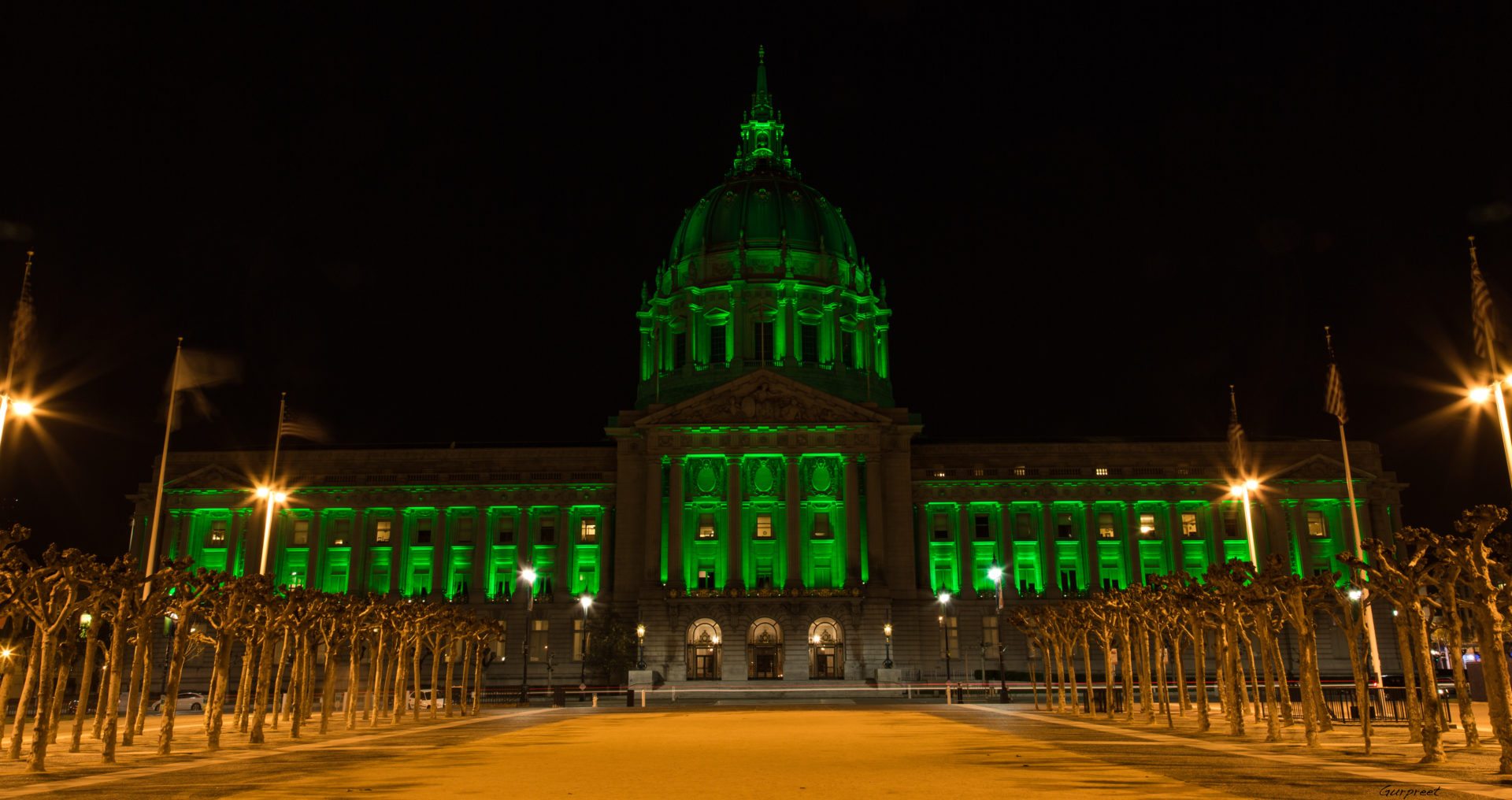
A 1600-Year-Old Tale…
And despite all of what you just read (Yes, believe it or not, you just read 5000 words), there is much more to Ireland and Paddy’s Day. St. Patrick’s Day gives you an excuse to have whiskey in your system while the sun is up, and some people could use it these days. As long as you remember your green threads, St. Patrick’s Day is delightful.
Don’t forget to check out other related Irish stories and blogs that might interest you: Get to Know Some of The Famous Irish Proverbs| St. Patrick Day in Northern Ireland| Digging into the Secret of Irish Pookas|


